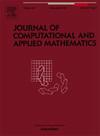A nodally bound-preserving finite element method for time-dependent convection–diffusion equations
IF 2.1
2区 数学
Q1 MATHEMATICS, APPLIED
Journal of Computational and Applied Mathematics
Pub Date : 2025-04-17
DOI:10.1016/j.cam.2025.116691
引用次数: 0
Abstract
This paper presents a new method to approximate the time-dependent convection–diffusion equations using conforming finite element methods, ensuring that the discrete solution respects the physical bounds imposed by the differential equation. The method is built by defining, at each time step, a convex set of admissible finite element functions (that is, the ones that satisfy the global bounds at their degrees of freedom) and seeks for a discrete solution in this admissible set. A family of -schemes is used as time integrators, and well-posedness of the discrete schemes is proven for the whole family, but stability and optimal-order error estimates are proven for the implicit Euler scheme. Nevertheless, our numerical experiments show that the method also provides stable and optimally-convergent solutions when the Crank–Nicolson method is used.
时变对流扩散方程的节点保界有限元方法
本文提出了一种新的方法来逼近随时间变化的对流扩散方程,并保证离散解遵守微分方程所施加的物理边界。该方法是通过在每个时间步定义一个可容许的有限元函数(即在其自由度上满足全局边界的函数)的凸集并在该可容许集中寻求离散解来建立的。采用一组θ-格式作为时间积分器,证明了整个离散格式的适定性,但证明了隐式欧拉格式的稳定性和最优阶误差估计。然而,我们的数值实验表明,当使用Crank-Nicolson方法时,该方法也提供了稳定和最优收敛的解。
本文章由计算机程序翻译,如有差异,请以英文原文为准。
求助全文
约1分钟内获得全文
求助全文
来源期刊
CiteScore
5.40
自引率
4.20%
发文量
437
审稿时长
3.0 months
期刊介绍:
The Journal of Computational and Applied Mathematics publishes original papers of high scientific value in all areas of computational and applied mathematics. The main interest of the Journal is in papers that describe and analyze new computational techniques for solving scientific or engineering problems. Also the improved analysis, including the effectiveness and applicability, of existing methods and algorithms is of importance. The computational efficiency (e.g. the convergence, stability, accuracy, ...) should be proved and illustrated by nontrivial numerical examples. Papers describing only variants of existing methods, without adding significant new computational properties are not of interest.
The audience consists of: applied mathematicians, numerical analysts, computational scientists and engineers.

 求助内容:
求助内容: 应助结果提醒方式:
应助结果提醒方式:


